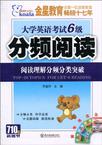大学英语考试4级分频阅读-阅读理解分频分类突破
出版时间:2010-7 出版社:东北师范大学出版社 作者:乔爱玲 编 页数:316
前言
你是否也有这样的困惑:背了厚厚的单词书、记住了大量的4级单词后,却依然在做阅读理解题时茫然无措;文章的每一个单词都认识,却依然不知文章所云;做了大量的阅读题,错误率却反而升高了! 其实,你不懂大学英语新四级考试的阅读理解! 阅读理解部分的文章不是简单的单词堆砌,命题人在其中加了许多的陷阱!阅读理解部分的文章不是简单的文章组合,命题人的思路在历年的真题中露出了马脚! 我们一起看一下命题人精心设下的陷阱和我们应该采取的策略: 命题陷阱一:阅读理解没有规律性! 考生误区一:所以多练就可以提高成绩.题海战术嘛! 不可否认,多练习阅读理解题型,对于阅读理解会有一定的帮助。我们不妨看一下这个案例:在某大学巡讲结束的时候,有一位女生非常急切的走到我的面前问:老师,我有一个困惑。我对阅读理解部分进行了大量的练习:做第一篇练习的时候,我错了两道题,做到第100篇的时候,我反而错了三道题。这是为什么?经过仔细的询问后,我给出了下面的解答。 考拉进阶策略一:分频分类,专项突破。
内容概要
专业:研发人员全部由国内外大学教授、教育专家、留学归国人员及英语专业精英人才组成。 方法:融合最新教育学、心理学、测试学、计算机技术和创新思维等手段,解决中国人特别是中国学生不知如何学好英语的苦恼。 专注:考拉进阶信奉“术有专攻,业有专精”,专心只做一件事:研究开发适合中国人快速掌握英语的技术和方法 效率:方法领先,事半功倍;高效率,轻松学,好成绩,这就是Koalagogo欲求达到的功效。
书籍目录
Part Ⅰ 新题型解读 第一章 快速阅读 一、题型揭秘 二、阅读时间与效率的博弈之一 三、正向定位解题法示范 第二章 选词填空 一、题型揭秘 二、阅读时间与效率的博弈之二 三、分类排除解题法示范 第三章 简答题 一、题型揭秘 二、阅读时间与效率的博弈之三 三、正向定位解题法的沿用 第四章 短文理解 一、题型揭秘 二、阅读时间与效率的博弈之四 三、题型解题示范 1.主旨类题 2.细节类题 3.推断类题 4.态度类题 5.语义类题Part Ⅱ 分频分类突破 第一章 科技科普类 Module 1 科技与发展 Module 2 灾害与预防 Module 3 心理与健康 Module 4 医疗与健康 第二章 人文生活类 Module 5 影视与生人 Module 6 体育与人生 Module 7 爱情与婚姻 Module 8 人性与人际关系 第三章 经济社会类 Module 9 经济与发展 Module 10 新闻与热点 Module 11 新闻与媒体 Module 12 国家和民族 第四章 文化教育类 Module 13 文化与生活 Module 14 教育与立志 Module 15 教育与社会 Module 16 语言与交际 第五章 环境卫生类 Module 17 污染与治理 Module 18 人口与环境 Module 19 交通与节能 Module 20 治安与犯罪
章节摘录
When we think of Hollywood —— a term used loosely to describe American movie production ingeneral, not simply films made in Los Angeles —— we think of films aimed at amusing audiences andmaking money for producers. During the early years of the new century, as workers won their demands for higher wages and ashorter working week, leisure assumed an increasingly important role in everyday life. Amusementparks, professional baseball games, and dance halls attracted a wide array of men and women anxiousto spend their hard earned dollars in the pursuit of fun and relaxation. Yet of all these new culturalendeavors, films were the most important and widely attended source of amusement. For a mere fiveor ten cents, even the poorest worker could afford to take himself and his family to the storefronttheatre. Taking root in urban working-class and immigrant neighborhoods, cinemas soon spread tomiddle-class districts of cities and into small communities throughout the nation. "Every little townthat has never been able to afford and maintain an open house," observed one journalist in 1980,~now boasts one or two Bijou Dreams". By 1910, the appeal of films was so great that nearly one-third of the nation flocked to the cinema each week; ten years later, weekly attendance equaled 50percent of the nations population. Early films were primarily aimed at entertaining audiences, but entertainment did not alwayscome in the form of escapist fantasies. Many of the issues that donated progressive-era politics werealso portrayed on the screen. "Between 1900 and 1917," observes Kevin Brownlow, "Literallythousands of films dealt with the most pressing problems of the day —— white slavery, politicalcorruption, gangsterism, loansharking, slum landlords, capital vs. labor, racial prejudice, etc."While most of these films were produced by studios and independent companies, a significant numberwere made by what we might call today "special interest groups". As films quickly emerged as thenations most popular form of mass entertainment, they attracted the attention of a wide range oforganizations that recognized the mediums enormous potential for disseminating propaganda tomillions of viewers.
编辑推荐
金星教育畅销十七年 全国一亿读者首选 分频分类 科学高效 真题同源 联结特训
图书封面
评论、评分、阅读与下载
大学英语考试4级分频阅读-阅读理解分频分类突破 PDF格式下载
用户评论 (总计1条)
- 1版本太旧 很多题型很多年前就不考了
2有印刷错误
3可练阅读 但不适合考生考6及
